|
|
|
Sort Order |
|
|
|
Items / Page
|
|
|
|
|
|
|
| Srl | Item |
| 1 |
ID:
133382
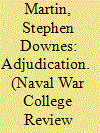

|
|
|
|
|
| Publication |
2014.
|
| Summary/Abstract |
Commonly used war-game adjudication methods break down and create unreliable results when addressing novel operational or strategic problems for which we have little experience or data (for example, information warfare or a regional nuclear conflict) and when we wish to explore situations rather than educate officers about well-understood situations. The primary causes of this breakdown are, first, the incorrect assumption that adjudicators are impartial controllers instead of dominant players and, second, the design choice to make the players' decisions the game's primary output. Among the many reasons for war gaming (such as research and analysis, training, education, and discovery), this article focuses on "discovery" war games, where the objective is to find out something previously unknown about a novel operational or strategic problem, something that cannot be better discovered by other methods, such as seminars, work groups, modeling and simulation, or operations research.
|
|
|
|
|
|
|
|
|
|
|
|
|
|
|
|
| 2 |
ID:
132005
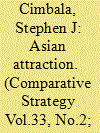

|
|
|
|
|
| Publication |
2014.
|
| Summary/Abstract |
The United States' military-strategic pivot toward Asia is motived by concerns about a rising China, about the increased significance of Asia on the world economic and political stages, and about the growing risks of nuclear proliferation and nuclear first use in that region. Nuclear Asia already numbers five acknowledged or de facto nuclear weapons states among its members: Russia, China, North Korea, India, and Pakistan. Failure to reverse North Korea's nuclear weapons status or political distrust among other powers may increase the number of Asian nuclear weapons states (including states with prospective nuclear-missile reach into Asia) to eight, creating an Asian-Middle Eastern nuclear arms race that defies containment. On the other hand, an alternative presents itself, in the form of a multilateral nuclear arms reduction agreement that would create three tiers of accepted nuclear weapons states and bar the door to new admits.
|
|
|
|
|
|
|
|
|
|
|
|
|
|
|
|
| 3 |
ID:
134047
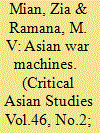

|
|
|
|
|
| Publication |
2014.
|
| Summary/Abstract |
The South Asian security landscape is increasingly dominated by a complex four-way dynamic between India, Pakistan, China, and the United States. The stresses and strains of the relationships between these states directly affect the prospects for peace and prosperity for almost half of humanity. This article describes some of the military contours of this landscape, with a focus on strategic postures, weapon acquisitions, and the role of nuclear weapons. It maps the India-Pakistan arms race over the past decade, the economic constraints on the two states, the role of China and the United States as weapons suppliers, and the risk and consequences for nuclear war. The authors then look at India's relationship with China, which is marked by both cooperation and competition, and the rise of China as a close military, political, and economic ally of Pakistan. While the United States has had long-standing cooperative relationships with both India and Pakistan, these relationships have been undergoing major shifts over the last two decades. U.S. concerns about China's increasing military and economic power have also intensified over this period as well. Of particular significance has been the effort to create a U.S.-India strategic partnership to balance and contain a rising China, which may become a central feature of the emerging global order. This article also offers a brief overview of what is publicly known about the nuclear arsenals of the four countries, ongoing production of weapons-usable fissile materials in Pakistan and India, as well as the race to build longer-range missiles.
|
|
|
|
|
|
|
|
|
|
|
|
|
|
|
|
| 4 |
ID:
131619
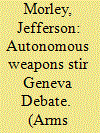

|
|
|
|
|
| Publication |
2014.
|
| Summary/Abstract |
The first multinational conference dedicated exclusively to robotic warfare took place May 13-16 at the UN Office at Geneva as governments around the world confront the emerging technologies that policymakers call "lethal autonomous weapons systems" and headline writers have dubbed "killer robots." The three-day meeting featured diplomats, scholars, and activists debating the implications of new weapons that could automatically target and kill people without human control. Although few such weapons exist now, revolutionary developments in sensors and robotics have stoked fears in some quarters that these weapons systems could make warfare less risky for the attacker and therefore more indiscriminate, but raised hopes in others that they might reduce civilian casualties.
|
|
|
|
|
|
|
|
|
|
|
|
|
|
|
|
| 5 |
ID:
132165
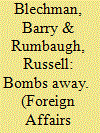

|
|
|
|
|
| Publication |
2014.
|
| Summary/Abstract |
In 1991, U.S. President George H. W. Bush decided to retire almost all the tactical nuclear weapons operated by the U.S. Army and the U.S. Navy. His reasons were simple: these short-range weapons were militarily useless and imposed significant burdens on the armed forces in terms of money, manpower, and time. Twenty-three years later, only one type of tactical nuclear weapon remains in the U.S. inventory: the B-61 gravity bomb. In addition to the several hundred B-61s located at home, the United States currently deploys around 180 of them in Europe, at bases in Belgium, Germany, Italy, the Netherlands, and Turkey. In the event of a nuclear conflict on the continent, NATO would deliver the bombs via U.S.-built F-15 or F-16 aircraft or European-built Tornado fighters, operated by some combination of Belgian, Dutch, German, Italian, and U.S. crews. Originally intended to prevent Soviet forces from penetrating Western Europe, the planes could travel as far east as Russia. But owing to their slower speed and lower altitude, they would be much more vulnerable to Russia's ground-based air defenses than would longer-range strategic bombers and missiles.
|
|
|
|
|
|
|
|
|
|
|
|
|
|
|
|
| 6 |
ID:
132586
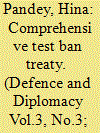

|
|
|
|
|
| Publication |
2014.
|
| Summary/Abstract |
Mushroom Clouds
Nuclear Age
Emerging Power
Atomic Bomb
Lethal Capabilities
Atomic Explosion
Nuclear Realm
Catastrophic Eventualities
Nuclear Hazards
Security Balance
Comprehensive Test Ban Treaty - CTBT
Nuclear Regime
American Perspective
Strategic Policy
|
|
|
|
|
|
|
|
|
|
|
|
|
|
|
|
| 7 |
ID:
131617
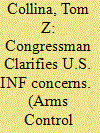

|
|
|
|
|
| Publication |
2014.
|
| Summary/Abstract |
A U.S. congressman provided new details in late April about the Obama administration's allegation that Russia may be breaching a key U.S.-Russian arms control treaty, stating that Moscow may have tested a cruise missile from a prohibited launcher. At a joint April 29 hearing of two House Foreign Affairs Committee panels, Rep. Brad Sherman (D-Calif.) said that Russia claims to have tested an intermediate-range missile for use at sea, which is allowed under the 1987 Intermediate-Range Nuclear Forces (INF) Treaty, but that Moscow used "what appears to be an operational, usable ground-based launcher," which is not allowed. Sherman said that "it appears as if [the Russians] were developing a ground-based capacity for this intermediate missile.
|
|
|
|
|
|
|
|
|
|
|
|
|
|
|
|
| 8 |
ID:
129103
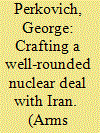

|
|
|
|
|
| Publication |
2014.
|
| Summary/Abstract |
A final nuclear deal with Iran should meet the underlying objective of the relevant UN Security Council resolutions since 2006: "the establishment of international confidence in the exclusively peaceful nature of Iran's nuclear programme."A final agreement could be codified and endorsed through a new resolution, which need not include all of the specific instrumental elements of past resolutions-for example, suspension of all uranium enrichment-if the council determines that the overall objective has been met. As the resolutions acknowledge, to be durable, such an agreement also must satisfy Iran's interest in having a purely peaceful nuclear program free from sanctions. The devilish challenge will be in the details. History will inform each party's requirements. The six-country group that has been negotiating with Iran, the so-called P5+1 (China, France, Germany, Russia, the United Kingdom, and the United States), will remember that Iran secretly had, at least until 2003, what appeared to be a dedicated, multifaceted program to acquire capabilities to produce nuclear weapons. Iran still has not cooperated fully with the International Atomic Energy Agency (IAEA) to clarify these activities and continues to expand sensitive fuel-cycle capabilities beyond any plausible civilian requirement. Iranian leaders, for their part, remember numerous episodes that reflect a U.S. determination to hasten an end to their regime.
|
|
|
|
|
|
|
|
|
|
|
|
|
|
|
|
| 9 |
ID:
133405
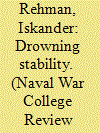

|
|
|
|
|
| Publication |
2012.
|
| Summary/Abstract |
In May 1998, the sun-scorched deserts of the Indian state of Rajasthan shook with a succession of nuclear explosions. Barely two weeks later, in a seemingly tit-for-tat response, Pakistan conducted its own series of detonations, in the remote western hills of Baluchistan. Both nations' previously concealed nuclear capabilities had suddenly burst out into the open, giving a new and terrifying form to the enduring rivalry that had convulsed the subcontinent for decades. Caught off guard, the international community reacted with indignation and dismay. Concerns over nuclear escalation in the event of another Indo-Pakistani conflict refocused Washington's attention on South Asia and triggered the longest sustained level of bilateral Indo-American engagement in history. This had the unexpected benefit of enabling both democracies finally to find common ground, after many years of acrimony, chronic mistrust, and squandered opportunities. Fears of mass terrorism in the wake of 9/11 and subsequent revelations of extensive proliferation emanating from Pakistan added urgency to Western desires to preserve a modicum of crisis stability in South Asia, as well as to prevent any form of escalatory behavior that could spiral into nuclear conflict or further the spread of radioactive material.
|
|
|
|
|
|
|
|
|
|
|
|
|
|
|
|
| 10 |
ID:
130939
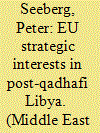

|
|
|
|
|
| Publication |
2014.
|
| Summary/Abstract |
Since the fall of Muammar Qadhafi in 2011, a legitimate monopoly over the means of violence has not been in the hands of the Libyan state. The military confrontation between the regime and what the international media called the "rebels," supported by the NATO no-fly zone, ended in October 2011. However, in 2012 and especially in 2013, Libya witnessed an escalating conflict pitting the democratically elected government and the Libyan state against armed groups and militias. For the EU, this is a challenge to its strategic interests, primarily security in the Mediterranean and secondarily migration and the development of Libya.
|
|
|
|
|
|
|
|
|
|
|
|
|
|
|
|
| 11 |
ID:
132674
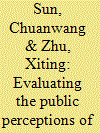

|
|
|
|
|
| Publication |
2014.
|
| Summary/Abstract |
After the Fukushima nuclear accident, more and more attention has been paid to the safety issues of nuclear power in China, even though it is a clean and necessary substitution to coal power. Due to the consideration about the uncertainty of nuclear safety, the local citizens may resist the nuclear power programs in their neighborhood, as indicated by the anti-nuclear movement in Jiangmen 2013. This phenomenon is often related to the public perceptions of "not-in-my-back-yard" (NIMABY). The explosion of anti-nuclear movements will impose adverse effects on the nuclear power decision-making in China. Based on the Contingent Valuation Method (CVM), we evaluate the public Willingness-To-Pay (WTP) for avoiding the construction of nuclear power plants in their neighborhood. Moreover, we analyze whether more information about nuclear energy could improve the public acceptance. Our results show that the comprehensive information will decrease the public risk perception of nuclear power and increase the public support for nuclear power policy. This paper further suggests that China×s decision makers should improve policy transparency and encourage the public involvement of nuclear energy decision making.
|
|
|
|
|
|
|
|
|
|
|
|
|
|
|
|
| 12 |
ID:
131670
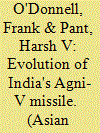

|
|
|
|
|
| Publication |
2014.
|
| Summary/Abstract |
India's Agni-V missile test of April 2012 opens new questions as to India's intentions. This article investigates three principal bureaucratic determinants of Indian military nuclear policy. Greater control over policymaking is required from the Prime Minister's Office to resolve governance questions surrounding India's nuclear policy.
|
|
|
|
|
|
|
|
|
|
|
|
|
|
|
|
| 13 |
ID:
128059
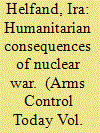

|
|
|
|
|
| Publication |
2013.
|
| Summary/Abstract |
In March, 130 nations gathered in Oslo for a two-day conference on the humanitarian consequences of nuclear war. The five countries that the nuclear Nonproliferation Treaty (NPT) recognizes as nuclear-weapon states staged a coordinated boycott, arguing that a meeting that discussed what will actually happen if nuclear weapons are used would somehow distract them from the important initiatives they are pursuing to lower the number of nuclear weapons that they possess. Next February, there will be a follow-up conference in Mexico to further delineate the medical effects of nuclear war as they are now understood and to consider the circumstances under which nuclear war might occur. Far from being a distraction, these meetings are helping to create the conditions necessary for the elimination of nuclear weapons. The United States and the four other NPT nuclear-weapon states should participate in the Mexico conference and actively promote the process launched in Oslo to educate policymakers and the general public about the catastrophic humanitarian consequences of nuclear war. This task is particularly urgent in view of the new data that have emerged over the last few years. This information indicates that even a very limited nuclear war, confined to one region of the globe, would have devastating effects worldwide.
|
|
|
|
|
|
|
|
|
|
|
|
|
|
|
|
| 14 |
ID:
131442
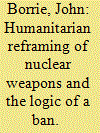

|
|
|
|
|
| Publication |
2014.
|
| Summary/Abstract |
The achievement of past international treaties prohibiting anti-personnel mines and cluster munitions showed that unpropitious political situations for dealing with the effects of problematic weapons could be transformed into concrete, legally binding actions through humanitarian-inspired initiatives. Although there is now renewed concern about the humanitarian consequences of nuclear weapons, some policy makers dispute the relevance of these past processes. This article examines how and why cluster munitions became widely reframed as unacceptable weapons, and the nature and significance of functional similarities with contemporary efforts of civil society activists to instigate humanitarian reframing of nuclear weapons and promote the logic of a ban treaty in view of its norm-setting value among states. In the case of cluster munitions, the weapon in question was signified as unacceptable in moral and humanitarian law terms because of its pattern of harm to civilians with reference to demonstrable evidence of the consequences of use. Ideational reframing was instigated by civil society actors, and introduced doubts into the minds of some policy-makers about weapons they had previously considered as unproblematic. This is relevant to the current discourse on managing and eliminating nuclear weapons in the Nuclear Non-Proliferation Treaty, in which there is dissonance between the rhetoric of those states claiming to be responsible humanitarian powers and their continued dependence on nuclear weapons despite questions about the utility or acceptability of these arms.
|
|
|
|
|
|
|
|
|
|
|
|
|
|
|
|
| 15 |
ID:
130876
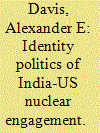

|
|
|
|
|
| Publication |
2014.
|
| Summary/Abstract |
Although its precise definition is contested, the concept of the 'Anglosphere' has grown in political discourse in the past decade. Anglospherist authors have defined it as a group of states tied together on the basis of shared tradition, laws, liberty and language. And yet they do not discuss India substantively, placing it firmly on the outside of its hierarchy. Others have argued the concept is based in a racialised, Anglo-Saxon identity. In 2005, Manmohan Singh surprised some domestic observers by emphasising India's positive connections to the 'English-speaking world' while speaking at Oxford University. Shortly after, India announced negotiations on a civil nuclear agreement with the US, leading to similar agreements with Canada, the UK and Australia. This article uses the contemporary India-US nuclear engagement to investigate India's position in relation to the ideational space of the Anglosphere and how this shapes India-Anglosphere relations. It is argued that India's postcolonial scepticism towards this space combined with the inherent anglocentrism in Anglosphere identity discourse limits India-Anglosphere relations while simultaneously animating nuclear engagement.
|
|
|
|
|
|
|
|
|
|
|
|
|
|
|
|
| 16 |
ID:
129109
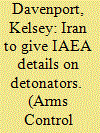

|
|
|
|
|
| Publication |
2014.
|
| Summary/Abstract |
Iran will provide the International Atomic Energy Agency (IAEA) with information about its past development of a detonator that could be used to as a trigger in nuclear weapons, according to an agreement reached by the two sides last month. In a Feb. 9 joint statement, Iran and the IAEA described the two days of talks in Tehran as "constructive" and announced seven actions for Iran to take by May 15 to further the agency's investigations into its unresolved concerns about Iran's current nuclear program and past actions. One of the actions requires Tehran to provide the IAEA with information on exploding bridge wire detonators, which can be used to trigger nuclear weapons. They can also be used in civilian applications, including drilling for oil and gas, and for conventional military explosives.
|
|
|
|
|
|
|
|
|
|
|
|
|
|
|
|
| 17 |
ID:
128060
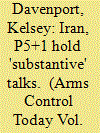

|
|
|
|
|
| Publication |
2013.
|
| Summary/Abstract |
Negotiations over Iran's controversial nuclear program were "substantive and forward looking," according to a joint statement released by officials representing Tehran and six world powers after talks Oct. 15-16 in Geneva. Wendy Sherman, U.S. undersecretary of state for political affairs and the leader of the U.S. delegation, said in an Oct. 16 interview with CNN that the parties held a "detailed, substantive discussion with a candor" she had not heard during the past two years of negotiations with Iran. The new negotiating team appointed by recently elected Iranian President Hassan Rouhani met for the first time with representatives from China, France, Germany, Russia, the United Kingdom, and the United States, known collectively as the P5+1, to resume talks on reaching an agreement on Iran's controversial nuclear program. The parties had agreed to resume negotiations after they met in New York on Sept. 26 and Rouhani spoke on the phone with U.S. President Barack Obama on Sept. 27.
|
|
|
|
|
|
|
|
|
|
|
|
|
|
|
|
| 18 |
ID:
129668
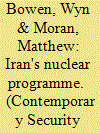

|
|
|
|
|
| Publication |
2014.
|
| Summary/Abstract |
This article examines Iranian proliferation behaviour through the lens of nuclear hedging. Defined as 'nuclear latency with intent', hedging is an area of proliferation behaviour that has not been fully explored. The Iranian case presents an outstanding example of the questions and types of evidence required to judge whether a nuclear programme is engaged in a hedging strategy. By examining a nuclear programme from three distinct angles - technical, narrative and diplomatic - key elements of strategic hedging can be identified. Applied to Iran, evidence supports a diagnosis of hedging. But this assessment is further complicated by Iran's domestic political context, which has engendered an approach that is as much 'hedging by default' as it is 'hedging by design'. This approach allows Tehran to reconcile restraint with domestic consensus on nuclear advancement. In this regard, our analysis shows that international exposure of Iran's undeclared nuclear activities had an enormous impact on the direction of Iran's nuclear programme, placing important constraints on Iran's nuclear progress. The article argues that any solution to the Iranian nuclear challenge must be based on realistic goals. The international community should focus on containing Iranian advancements rather than rollback, with a view to restricting hedging to a low level of latency.
|
|
|
|
|
|
|
|
|
|
|
|
|
|
|
|
| 19 |
ID:
129119
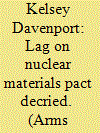

|
|
|
|
|
| Publication |
2014.
|
| Summary/Abstract |
The failure of several key states to ratify a nuclear security treaty ahead of this month's nuclear security summit is a disappointment, but an Indonesian initiative may increase the pace of ratifications, an official familiar with the preparations for the meeting said. The two previous nuclear security summits, in Washington in 2010 and Seoul in 2012, have emphasized the importance of the entry into force of a 2005 amendment to the Convention on the Physical Protection of Nuclear Material (CPPNM). The March 24-25 summit in The Hague is also likely to encourage ratification of this treaty. The original treaty, which entered into force in 1987, sets security standards for nuclear material in transit. Its 2005 amendment would expand the scope of the physical protection measures to cover material in storage. An additional 26 ratifications are necessary to reach the 98 necessary for bringing the amendment into force. Although the 2012 Seoul summit communiqué urged states "in a position to do so to accelerate their domestic approval" of the amendment in order to achieve entry into force by 2014, 17 of the 53 summit participants have yet to ratify it
|
|
|
|
|
|
|
|
|
|
|
|
|
|
|
|
| 20 |
ID:
132001
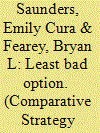

|
|
|
|
|
| Publication |
2014.
|
| Summary/Abstract |
This article examines the merits of extending the U.S. nuclear deterrent to the Middle East. It begins by looking at past practices of such an extension before delving into the overall issues presented by providing such a security guarantee. This article then looks at a brief survey of some of the regional issues facing a nuclear extension before considering the P-5 states and their concerns.
|
|
|
|
|
|
|
|
|
|
|
|
|
|
|
|
|
|
|
|
|